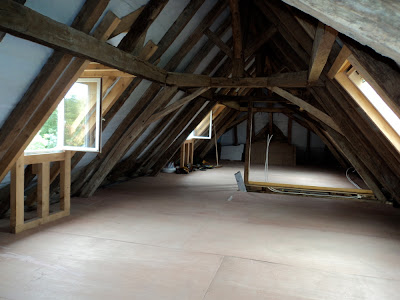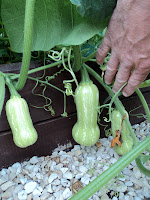We are trying to finish the little house before Christmas, and still have so many things to complete. My main task has been to renovate the exterior walls, which sounds like a relatively small undertaking, compared to the mountain of tasks that Nick has had to tackle.... but still it feels never-ending.
I had to chipper off all the render first, to expose the old stones. I needed to dig out all the old pointing that was dry and dusty, until I got back to the original mud pointing that was still solid. As we wanted to expose the stones, for 'pierres apparantes' I had to remove sufficient to enable the stones to stand proud after repointing. A hammer drill and a screwdriver, proved to be the most effective way to remove everything.
Having gone round the whole building twice, it was then time to clean the stones. After trying a number of methods, I settled on diluted chlorine and wire brushes (the technique advocated by our neighbouring farmer). It seems to take an age, having gone round the entire property at ground level, I then had to start again with a platform for the upper level. I can't say I'm looking forward to repeating this process on the barn! However it is starting to look beautiful...
Just one more round cleaning the top of the walls, and then I can start repointing, and buttering them to finish.
We used a sandblaster on the inside walls to clean the areas we wanted to expose like the chimney breast, as we also needed to clean the old wooden beams
It was a much quicker process, but still hard work particularly in the deep sea diving helmet that allowed you to breathe clean air. It was incredibly heavy, and the equipment rental firm had forgotten to give us a new visor for the front.
It was so difficult to see through the front panel (as the sand pitted the surface) that Nick had to remove it periodically to sand the surface flat....
Lay the foundations for the ground floor; lay cabling to take all the electrics; and pour and level the concrete.
To lay the flooring for the first floor, inch thick marine ply to ensure that it has no bounce...
To construct a unique front door made from oak planks taken from the barn, cleaned and planed to form an entrance both beautiful and original.....
To lay the framework for the decking at the rear of the property, while we wait for the sawmill to cut the 90 metres2 of chestnut we will lay....


And most recently to construct an oak staircase, made again from the oak planks he has reclaimed and cleaned from the barn..
I would feel slightly overwhelmed by the productivity compared to my meagre efforts, but I have also had responsibility for the vegetable garden, and here I have definitely restored the balance.
My cherry tomatoes started to crop in August and I have had four weeks now of continual harvesting...
In fact there have been so many, I have slow roasted over 300 tomatoes. I cut them in half, added a touch of salt and pepper and olive oil, and roasted them in the oven for 3 hours. The depth of flavour is amazing, so sweet and sticky, and great to add to pasta or salads. I have frozen most of them and they can be used straight from the freezer without reheating.
My other great passion has now become 'cucurbits'. I had never even heard of the word 8 weeks ago, but I now know that this is the family of pumpkins, squash and melons. And my interest is down to the fact that I seem to have the ideal soil, conditions and weather for growing them.
The first notion I had was when I realised that I had quite a few pumpkins growing in the patch and they were starting to get quite big. From the tiny seeds that I had grown in the greenhouse there were some sizeable fruit and a lot more flowers still being pollinated by the bees...
I was quite amazed when they started to
mature in August, swelling and ripening
on the vine...
I had thought that pumpkins were harvested in October ready for Halloween, and yet mine were definitely ripe and ready to be hardened off in mid August.... and so we started harvesting them
My butternut squash have taken a similar journey. Loads of tiny fruit set in July after the bees had done their work.... and then swelled on the vine...
Until I had 35 huge squash gradually turning a deep biscuit colour in the August sunshine..
And I planted 6 canteloupe melon seeds. After a profusion of tiny yellow flowers, the fruit started to grow....
I had read that it is best to cut off the smaller fruit to allow one or two per plant to reach full size, but I just didn't have the heart. So I left all the fruit on the vine to see how many would ripen...

And it seems that the Dordogne sunshine and the heavily manured raised beds we had built were perfect for them, so they all carried on growing to full size, and we are now harvesting melons on a daily basis.
They are sweet and honeyed and bursting with flavour.
It feels like a Harvest Festival display in the potager...... and yet it is only the end of August. However if the amount of new flowers on the cucurbit plants are a sign of things to come, then we should be harvesting all the way through till October. Anyone for soup.... !




















































